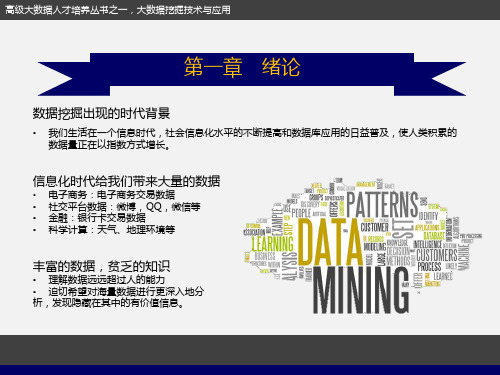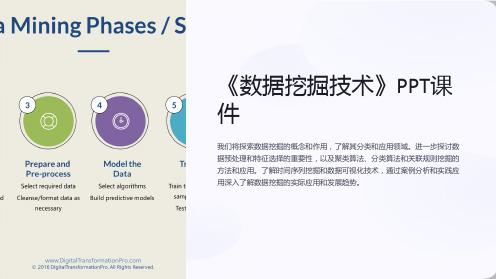中国科大 数据挖掘 slide7
数据科学导论-GitHub

数据科学导论Introduction to Data Science 第四章数据挖掘基础10/21/20171An Introduction to Data Science 刘淇Email: qiliuql@课程主页:/~qiliuql/DS2017.html基本概念——数据挖掘是什么?现今与未来:Data is everything and everything is data 从最不可能的地方获得数据2人的坐姿千差万别,这是数据吗?怎么获得?日本先进工业技术研究所的教授越水重臣基本概念——数据挖掘是什么?现今与未来:Data is everything and everything is data当一个人坐着的时候,他的身形、姿势和重量分布都可以量化和数据化3在汽车座椅下部安装360个压力传感器测量人对椅子施加的压力,用0~256的数值量化•把人体屁股特征转化成了数据,产生独属于每个乘坐者的精确数据资料。
•汽车可以准确的识别乘坐者的身份:汽车防盗系统基本概念——数据挖掘是什么?数据挖掘:从大量的数据中挖掘哪些令人感兴趣的、有用的、隐含的、先前未知的和可能有用的模式或知识,并据此更好的服务人们的生活。
4基本概念——数据挖掘是什么?数据挖掘的近义词从数据中挖掘知识知识提炼数据/模式分析数据考古 数据捕捞、信息收获、资料勘探等。
数据中的知识发现(KDD :Knowledge Discovery in Data )5统计学数据库机器学习可视化高性能人工智能数据挖掘参考书数据挖掘导论(Pang-Ning Tan, Michael Steinbach, Vipin Kumar, Addison Wesley )6四个任务——数据挖掘有哪些任务?7DataClustering ClassificationAssociationAnalysisAnomalyDetection8四个任务——聚类(Clustering):铁路票价制定如何制定合适的票价提高上座率?将旅客进行聚类分析,根据旅客乘坐高铁频率的不同提供不同的优惠政策。
数据挖掘

Single 90K
Yes
10
数据挖掘基础
5
Task
Attribute set, x
Class label, y
判断西瓜是否熟了 西瓜的条纹,藤蔓 熟的或是还未熟 ,大小,形状…
顾客流失率预测 打电话給顾客的数 流失或是不流失 据
判断用户的信用 应用平台(微博) 好的信用或是坏的
的数据
信用
垃圾邮件辨识
No
Married 80K
?
10
NO
MarSt
Single, Divorced
Married
< 80K
Income
NO > 80K
Assign Defaulted to “No”
NO
YES
数据挖掘基础
16
决策树——如何建立决策树?
Tid Attrib1 Attrib2
1 Yes
Large
2 No
Yes
6 No
Married 60K
No
7 Yes Divorced 220K No
8 No
Single 85K
Yes
9 No
Married 75K
No
10 No
Single 90K
Yes
10
数据挖掘基础
19
决策树——如何决策?
训练记录如何分裂?
选择测试条件的方法
依赖属性类型
评价测试条件
ID
Home Owner
Marital Status
Annual Defaulted Income Borrower
1 Yes Single 125K No
第1章 《数据挖掘》PPT绪论

Knowledge
Information
Data
3 of 43
1.1数据挖掘基本概念
第一章 绪论
1.1.1 数据挖掘的概念
数据挖掘、数据库、人工智能
• 数据挖掘是从数据中发掘知识的过程,在这个过程中人工智能和数据库技术可以作 为挖掘工具,数据可以被看作是土壤,云平台可以看作是承载数据和挖掘算法的基 础设施 。在挖掘数据的过程中需要用到一些挖掘工具和方法,如机器学习的方法。 当挖掘完毕后,数据挖掘还需要对知识进行可视化和展现。
21 of 43
1.3数据挖掘常用工具
第一章 绪论
1.3.2 开源工具
• WEKA WEKA 是一个基于JAVA 环境下免费开源的数据挖掘工作平台,集合了大量能承担数据 挖掘任务的机器学习算法,包括对数据进行预处理,分类,回归、聚类、关联规则以及 在新的交互式界面上的可视化。
22 of 43
1.3数据挖掘常用工具
•R • Weka • Mahout • RapidMiner • Python • Spark MLlib
第一章 绪论
20 of 43
1.3数据挖掘常用工具
第一章 绪论
1.3.2 开源工具
•R R是用于统计分析和图形化的计算机语言及分析工具,提供了丰富的统计分析和数据挖 掘功能,其核心模块是用C、C++和Fortran编写的。
为了提高系统的决策支持能力,像ERP、SCM、HR等一些应用系统也逐渐与数据 挖掘集成起来。多种理论与方法的合理整合是大多数研究者采用的有效技术。
12 of 43
1.2 数据挖掘起源及发展历史
第一章 绪论
3 数据挖掘面临的新挑战
随着物联网、云计算和大数据时代的来临,在大数据背景下数据挖掘要面临的挑 战,主要表现在以下几个方面:
中科大数据挖掘和数据仓库第一讲概述

Data Mining, November 27, 2014
11/24
让人憎恨/喜爱的数据利用
思考 1: 手机软件泄漏个人隐私: 位置信息,通话记录, 软件开发者用这这 些企业能进一步改进吗?
要挖掘的数据
数据库:关系,面向对象,异构,遗产 数据仓库 事物数据库 流式数据,时空数据库,时间序列 文本和 web 多媒体数据 图、社交网络和信息网络
挖掘的方法
流式计算/云计算/云存储 数据仓库 机器学习 统计学 模式识别 可视化 高性能计算
挖掘出的知识
特征 区别 关联 类别 聚类 趋势/偏离 孤立点分析
6/24
为什么要进行数据挖掘
Data Mining, November 27, 2014
6/24
为什么要进行数据挖掘
信息技术的发展和进步,产生了新的生产领域: 计算机:保存和处理信息的工具 计算机网络:共享信息 物联网:信息收集能力的扩展 移动通信:信息收集和共享的增强
Data Mining, November 27, 2014
Data Mining, November 27, 2014
8/24
科大的每年会有多少数据产生?
每个人每天:1MB 假设 1 万人:10GB 每年: 3.65TB 假设一个人每分钟可以阅读 1KB 的内容,则读完科大每年产生的数 据需要:3650000000/60/24/365 年>6900 年 其它例子
Data Mining, N喜爱的数据利用
思考 1: 手机软件泄漏个人隐私: 位置信息,通话记录, 软件开发者用这些信息干什么?
Data Mining, November 27, 2014
11/24
让人憎恨/喜爱的数据利用
数据挖掘技术在科学研究中的应用

数据挖掘技术在科学研究中的应用随着信息技术的不断发展和应用,人们储存和处理数据的能力越来越强,数据的规模和复杂度也越来越大。
数据挖掘是一种从大量数据中自动发现隐藏的模式、关系或知识的过程,涉及到多个学科和领域,如计算机科学、统计学、数学、工程学等。
数据挖掘技术在科学研究中的应用越来越广泛,可以帮助研究者在繁杂的数据中发现规律、提取特征、建立模型、进行预测,大大提高科学研究的效率和准确性。
一、医学研究在医学研究中,数据挖掘可以帮助研究人员挖掘大量的医学数据,根据不同疾病的特征建立预测模型,可以用来预测病情的发展和预测治疗效果。
例如,美国国立卫生研究院(National Institutes of Health)使用了数据挖掘技术,分析了5000份来自世界各地的癫痫病人的数据,构建了一个预测模型,可以帮助医生更好地预测癫痫病人的发作时间和模式。
二、社交网络分析社交网络分析是近年来研究较为热门的方向,在社交网络中,人与人之间的联系构成了庞大的人际关系网络,社交网络分析可以帮助我们更好地了解人际关系,分析网络中的某些群体、个体特征和信息传递规律。
例如,有研究者使用社交网络分析技术,对美国国会议员之间的连接进行了深入研究,发现议员之间的联系和政治立场密切相关,通过这些分析可以更好地观测政治局势变化和政策形成。
三、气象研究气象研究是一种需要大规模观测数据的研究,气象数据的分析和处理对相关气象服务和应用的发展极为重要。
而数据挖掘技术可以在海量的气象数据中挖掘出有用的气象特征和规律,有助于建立准确的气象预测模型,提高气象预测精度。
例如,国内外的一些大型气象机构和研究单位都纷纷采用数据挖掘技术,并取得了显著的效果。
四、环境监测环境监测工作需要全面、准确地掌握环境数据,例如空气质量、水质、土壤、声音、光线等方面数据。
数据挖掘技术可以帮助研究人员在大量数据中挖掘出环境变化的规律和特征,有效预测和预警环境事件,并在环境保护工作中提供科学的参考。
数据挖掘顶级期刊简介

顶级会议第一KDD 第二SIAM ICDM中国计算机学会推荐国际学术刊物(数据库、数据挖掘与内容检索)序号刊物简称刊物全称出版社网址1 TODS ACM Transactions on Database Systems ACM /tods/2 TOIS ACM Transactions on Information andSystems ACM /pubs/tois/3 TKDE IEEE Transactions on Knowledge and Data Engineering IEEE Computer Society /tkde/4 VLDBJ VLDB Journal S pringer-Verlag/dblp/db/journals/vldb/index.html二、B类序号刊物简称刊物全称出版社网址1 TKDD ACM Transactions on Knowledge Discovery from Data ACM/pubs/tkdd/2 AEI Advanced Engineering Informatics Elsevier/wps/find/journaldescription.cws_home/622240/3 DKE Data and Knowledge Engineering Elsevier/science/journal/0169023X4 DMKD Data Mining and Knowledge DiscoverySpringer/content/100254/5 EJIS European Journal of Information Systems The OR Society/ejis/6 GeoInformatica Springer /content/1573-7624/7 IPM Information Processing and Management Elsevier/locate/infoproman8 Information Sciences Elsevier /locate/issn/002002559 IS Information Systems Elsevier/information-systems/10 JASIST Journal of the American Society for Information Science and TechnologyAmerican Society for Information Science and Technology /Publications/JASIS/jasis.html11 JWS Journal of Web Semantics Elsevier /locate/inca/67132212 KIS Knowledge and Information Systems Springer /journal/1011513 TWEB ACM Transactions on the Web ACM /三、C类序号刊物简称刊物全称出版社网址1 DPD Distributed and Parallel Databases Springer/content/1573-7578/2 I&M Information and Management E lsevier /locate/im/3 IPL Information Processing Letters Elsevier /locate/ipl4 Information Retrieval Springer /issn/1386-45645 IJCIS International Journal of Cooperative Information Systems World Scientific/ijcis6 IJGIS International Journal of Geographical Information Science Taylor & Francis/journals/tf/13658816.html7 IJIS International Journal of Intelligent Systems Wiley/jpages/0884-8173/8 IJKM International Journal of Knowledge Management IGI/journals/details.asp?id=42889 IJSWIS International Journal on Semantic Web and Information Systems IGI/10 JCIS J ournal of Computer Information Systems IACIS/web/journal.htm11 JDM Journal of Database Management IGI-Global/journals/details.asp?id=19812 JGITM Journal of Global Information Technology Management Ivy League Publishing/bae/jgitm/13 JIIS Journal of Intelligent Information Systems Springer/content/1573-7675/14 JSIS Journal of Strategic Information Systems Elsevier/locate/jsis中国计算机学会推荐国际学术刊物(数据库、数据挖掘与内容检索)一、A类序号刊物简称刊物全称出版社网址1 TODS ACM Transactions on Database Systems ACM /tods/2 TOIS ACM Transactions on Information andSystems ACM /pubs/tois/3 TKDE IEEE Transactions on Knowledge and Data Engineering IEEE Computer Society /tkde/4 VLDBJ VLDB Journal S pringer-Verlag/dblp/db/journals/vldb/index.html二、B类序号刊物简称刊物全称出版社网址1 TKDD ACM Transactions on Knowledge Discovery from Data ACM/pubs/tkdd/2 AEI Advanced Engineering Informatics Elsevier/wps/find/journaldescription.cws_home/622240/3 DKE Data and Knowledge Engineering Elsevier/science/journal/0169023X4 DMKD Data Mining and Knowledge DiscoverySpringer/content/100254/5 EJIS European Journal of Information Systems The OR Society/ejis/6 GeoInformatica Springer /content/1573-7624/7 IPM Information Processing and Management Elsevier/locate/infoproman8 Information Sciences Elsevier /locate/issn/002002559 IS Information Systems Elsevier/information-systems/10 JASIST Journal of the American Society for Information Science and TechnologyAmerican Society for Information Science and Technology /Publications/JASIS/jasis.html11 JWS Journal of Web Semantics Elsevier /locate/inca/67132212 KIS Knowledge and Information Systems Springer /journal/1011513 TWEB ACM Transactions on the Web ACM /三、C类序号刊物简称刊物全称出版社网址1 DPD Distributed and Parallel Databases Springer/content/1573-7578/2 I&M Information and Management E lsevier /locate/im/3 IPL Information Processing Letters Elsevier /locate/ipl4 Information Retrieval Springer /issn/1386-45645 IJCIS International Journal of Cooperative Information Systems World Scientific/ijcis6 IJGIS International Journal of Geographical Information Science Taylor & Francis/journals/tf/13658816.html7 IJIS International Journal of Intelligent Systems Wiley/jpages/0884-8173/8 IJKM International Journal of Knowledge Management IGI/journals/details.asp?id=42889 IJSWIS International Journal on Semantic Web and Information Systems IGI/10 JCIS J ournal of Computer Information Systems IACIS/web/journal.htm11 JDM Journal of Database Management IGI-Global/journals/details.asp?id=19812 JGITM Journal of Global Information Technology Management Ivy League Publishing/bae/jgitm/13 JIIS Journal of Intelligent Information Systems Springer/content/1573-7675/14 JSIS Journal of Strategic Information Systems Elsevier/locate/jsis一、以下是一些数据挖掘领域专家牛人的网站,有很多精华,能开阔研究者的思路,在此共享:1.Rakesh Agrawal主页:/en-us/people/rakesha/ 数据挖掘领域唯一独有的关联规则研究的创始人,其主要的Apriori算法开启了这一伟大的领域。
医学科研数据挖掘概述

个性化医疗
通过分析患者的基因、生活习惯等数据,可以为患者提供 个性化的治疗方案和健康管理计划。
药物研发与优化
数据挖掘技术可以帮助科研人员从海量数据中挖掘出与药 物作用相关的关键信息,加速药物研发过程,提高药物疗 效。
医学教育与培训
数据挖掘技术可以应用于医学教育和培训领域,通过分析 学生的学习行为和成绩等数据,为教师提供有针对性的教 学建议,提高教学效果。
点不同。
统计分析侧重于对已知假设进行 验证和推断,而数据挖掘则侧重 于从数据中发现新的知识和模式。
数据挖掘可以利用统计分析的方 法和技术,但还需要结合其他技 术和方法,如机器学习、深度学
习等。
03 医学科研数据挖掘的常用 方法
描述性统计方法
频数分布和交叉表分析
用于描述数据的分布情况和不同变量之间的关系。
个性化医疗与精准医学
个性化治疗方案制定
基于患者的基因、生活习惯等个性化信息,利用数据挖掘技术制定 个性化的治疗方案。
精准医学实践
结合大数据和人工智能技术,实现精准医学在疾病预防、诊断和治 疗等方面的应用。
患者管理与随访
通过数据挖掘技术,对患者的管理和随访进行优化,提高患者治疗依 从性和生活质量。
05 医学科研数据挖掘的挑战 与前景
建立完善的数据质量控制 和管理体系,确保数据的 准确性、完整性和一致性 ,为医学科研数据挖掘提 供可靠的数据基础。
在数据收集、存储和使用 过程中,严格遵守隐私保 护相关法律法规和伦理规 范,切实保障患者隐私和 数据安全。
关注大数据、人工智能等 前沿技术的发展动态,积 极探索新技术在医学科研 数据挖掘中的应用,提高 挖掘效率和准确性。
医学科研数据挖掘概述
目 录
(完整word版)数据挖掘与实验报告(word文档良心出品)

中科大数据挖掘实验报告姓名樊涛声班级软设一班学号SA15226248实验一K邻近算法实验一实验内容使用k近邻算法改进约会网站的配对效果。
海伦使用约会网址寻找适合自己的约会对象,约会网站会推荐不同的人选。
她将曾经交往过的的人总结为三种类型:(1)不喜欢的人(2)魅力一般的人(3)极具魅力的人尽管发现了这些规律,但依然无法将约会网站提供的人归入恰当的分类。
使用KNN算法,更好的帮助她将匹配对象划分到确切的分类中。
二实验要求(1)独立完成kNN实验,基本实现可预测的效果(2)实验报告(3)开放性:可以自己增加数据或修改算法,实现更好的分类效果三实验步骤(1)数据源说明实验给出的数据源为datingTestSet.txt,共有4列,每一列的属性分别为:①percentage of time spenting playing vedio games;②frequent flied miles earned per year;③liters of ice cream consumed per year;④your attitude towars this people。
通过分析数据源中的数据,得到规律,从而判断一个人的前三项属性来得出划分海伦对他的态度。
(2)KNN算法原理对未知属性的某数据集中的每个点一次执行以下操作①计算已知类别数据集中的每一个点和当前点的距离②按照距离递增依次排序③选取与当前点距离最小的k个点④确定k个点所在类别的出现频率⑤返回k个点出现频率最高的点作为当前点的分类(3)KNN算法实现①利用python实现构造分类器首先计算欧式距离然后选取距离最小的K个点代码如下:def classify(inMat,dataSet,labels,k):dataSetSize=dataSet.shape[0]#KNN的算法核心就是欧式距离的计算,一下三行是计算待分类的点和训练集中的任一点的欧式距离diffMat=tile(inMat,(dataSetSize,1))-dataSetsqDiffMat=diffMat**2distance=sqDiffMat.sum(axis=1)**0.5#接下来是一些统计工作sortedDistIndicies=distance.argsort()classCount={}for i in range(k):labelName=labels[sortedDistIndicies[i]]classCount[labelName]=classCount.get(labelName,0)+1;sortedClassCount=sorted(classCount.items(),key=operator.itemgetter(1),reverse=True) return sortedClassCount[0][0]②解析数据输入文件名,将文件中的数据转化为样本矩阵,方便处理代码如下:def file2Mat(testFileName,parammterNumber):fr=open(testFileName)lines=fr.readlines()lineNums=len(lines)resultMat=zeros((lineNums,parammterNumber))classLabelVector=[]for i in range(lineNums):line=lines[i].strip()itemMat=line.split('\t')resultMat[i,:]=itemMat[0:parammterNumber]classLabelVector.append(itemMat[-1])fr.close()return resultMat,classLabelVector;返回值为前三列属性被写入到resultMat二维数组中,第四列属性作为标签写入到classLableVector中③归一化数据不同评价指标往往具有不同的量纲和量纲单位,这样的情况会影响到数据分析的结果,为了消除指标之间的量纲影响,需要进行数据标准化处理,使各指标处于同一数量级。
《数据挖掘技术》课件

拆分时间序列成趋势、周期和随机成分,了解时间序列的特征。
2
时间序列预测
通过历史数据建模和预测,预测未来时间点的趋势和模式。
3
金融市场预测
应用时间序列挖掘来预测股票价格、汇率等金融指标。
大数据时代下的挖掘技术发展趋势
人工智能
深度学习、自然语言处理等在数 据挖掘中的应用。
云计算
通过弹性计算和分布式存储实现 大规模数据挖掘。
医疗诊断
利用医疗数据挖掘技术来辅助医生进行疾病诊断。
社交网络分析
挖掘社交网络中的关系和用户行为模式。
数据清洗、数据集成、数据转换和数据规约。
特征选择
评估特征的重要性,剔除冗余和无关特征,提高模型准确性。
数据质量
解决数据缺失、异常数据和噪声数据,保证数据的准确性和完整性。
聚类算法与分类算法
聚类算法
基于距离或相似性将数据划分为 不同的群集,发现数据的内在结 构。
分类算法
通过训练数据构建决策树,对新 的未知数据进行分类或预测。
物联网
连接设备和传感器的数据挖掘和 分析。
数据可视化技术与数据分析
可视化工具
使用图表、地图和仪表盘等可视化工具
数据分析
2
来展现数据。
通过统计分析和交互式探索来发现数据
的隐藏关系。
3
故事呈现
通过数据可视化技术将数据转化为有意 义的故事。
数据挖掘案例分析和应用实践
市场营销
通过分析客户购买数据来制定营销策略。
支持向量机
通过在特征空间中创建超平面将 不同类别的数据分隔开。
关联规则挖掘及其应用
1 频繁项集
发现同时出现频率较高的 商品或事物组合。
医学科研数据挖掘概述ppt课件

在偏差中包括很多有用的知识,数据库中的数据 存在很多异常情况,发现数据库中数据存在的异常情 况是非常重要的。偏差检验的基本方法就是寻找观察 结果与参照之间的差别。
六、挖掘方法
1. 关联分析法 2. 决策树 3. 人工神经网络 4. 遗传算法 5. 聚类分析 6. 序列模式分析
1. 关联分析(association analysis)
关联规则挖掘是由rakesh apwal等人首先提出。 两个或两个以上变量的取值之间存在某种规律性, 就称为关联。数据关联是数据库中存在的一类重 要的、可被发现的知识。关联分为简单关联、时 序关联和因果关联。关联分析的目的是找出数据 库中隐藏的关联网。一般用支持度和可信度两个 阀值来度量关联规则的相关性,还不断引入兴趣 度、相关性等参数,使得所挖掘的规则更符合需 求。
数据的转换:将数据转换成一个分析模型。这个 分析模型是针对挖掘算法建立的。建立一个真正 适合挖掘算法的分析模型是数据挖掘成功的关键。
数据挖掘:对所得到的经过转换的数据进行挖掘。 结果分析:解释并评估结果。其使用的分析方法
一般应作数据挖掘操作而定。 知识的同化:将分析所得到的知识集成到业务信
息系统的组织结构中去。
5. 聚集分析(Cluster analysis ,CA)
聚集是把整个数据库分成不同的群组。它的 目的是要群与群之间差别很明显, 而同一个群之 间的数据尽量相似。此外聚类分析可以作为其他 算法( 如特征和分类等) 的预处理步骤, 之后这些 算法再在生成的簇上进行处理。与分类不同, 在 开始聚集之前不知道要把数据分成几组, 也不知 道怎么分( 依照哪几个变量) 。因此在聚集之后要 有一个对业务很熟悉的人来解释这样分群的意义 。很多情况下一次聚集得到的分群对某个业务来 说可能并不好, 这时就需要删除或增加变量以影 响分群的方式, 经过几次反复之后才能最终得到 一个理想的结果。聚类方法主要有两类: 统计方 法和神经网络方法。
数据挖掘ppt课件

情感分析:情感词典构建、情感倾向判断等
情感词典构建
收集和整理表达情感的词汇,构 建情感词典,为情感分析提供基 础数据。
情感倾向判断
利用情感词典和文本表示模型, 判断文本的情感倾向,如积极、 消极或中立。
深度学习方法
如循环神经网络(RNN)、长短 期记忆网络(LSTM)等,用于捕 捉文本中的时序信息和情感上下 文。
通过准确率、灵敏度、特异度等指 标评估模型性能,将模型应用于实 际医疗场景中,提高医生诊断效率 和准确性。
疾病预测与辅助诊断模型构建
利用机器学习、深度学习等技术构 建疾病预测和辅助诊断模型,如决 策树、神经网络、卷积神经网络等 。
谢谢您的聆听
THANKS
模型评估与优化
通过准确率、召回率、F1值等 指标评估模型性能,采用交叉 验证、网格搜索等方法优化模
型参数。
金融欺诈检测模型构建与优化
金融欺诈类型及特点
信用卡欺诈、贷款欺诈、洗钱等。
数据来源与处理
交易数据、用户行为数据、第三方数据等,进行数据清洗、特征工程 等处理。
欺诈检测模型构建
利用有监督学习、无监督学习等技术构建欺诈检测模型,如支持向量 机、随机森林、聚类等。
数据挖掘ppt课件
CONTENTS
• 数据挖掘概述 • 数据预处理技术 • 关联规则挖掘方法 • 分类与预测方法 • 聚类分析方法 • 时间序列分析方法 • 文本挖掘技术 • 数据挖掘在实际问题中应用案
01
数据挖掘概述
定义与发展历程
定义
数据挖掘是从大量数据中提取出 有用信息和知识的过程。
发展历程
应用
FP-Growth算法适用于大型数据集和复杂关联规则的挖掘,如电商网站的推荐 系统、网络安全领域的入侵检测等。
数据挖掘_国防科技大学中国大学mooc课后章节答案期末考试题库2023年

数据挖掘_国防科技大学中国大学mooc课后章节答案期末考试题库2023年1.某超市研究销售纪录数据后发现,买啤酒的人很大概率也会购买尿布,这种属于数据挖掘的哪类问题?()答案:关联规则发现2.下列有关SVM说法不正确的是()答案:SVM因为使用了核函数,因此它没有过拟合的风险3.影响聚类算法效果的主要原因有:()答案:特征选取_聚类准则_模式相似性测度4.7、朴素贝叶斯分类器不存在数据平滑问题。
( )答案:错误5.决策树中包含一下哪些结点答案:内部结点(internal node)_叶结点(leaf node)_根结点(root node) 6.标称类型数据的可以利用的数学计算为:众数7.一般,k-NN最近邻方法在( )的情况下效果较好答案:样本较少但典型性好8.考虑两队之间的足球比赛:队0和队1。
假设65%的比赛队0胜出、P(Y=0)=0.65。
剩余的比赛队1胜出、P(Y=1)=0.35。
队0获胜的比赛中只有30%在队1的主场、P(X=1|Y=0)=0.3,而队1获胜的比赛中75%是主场获胜、P(X=1|Y=1)=0.75。
则队1在主场获胜的概率即P(Y=1|X=1)为:()答案:0.579.一组数据的最小值为12,000,最大值为98,000,利用最小最大规范化将数据规范到[0,1],则73,000规范化的值为:()答案:0.71610.以下哪个分类方法可以较好地避免样本的不平衡问题:()答案:KNN11.简单地将数据对象集划分成不重叠的子集,使得每个数据对象恰在一个子集中,下列哪些不属于这种聚类类型层次聚类_模糊聚类_非互斥聚类12.数据点密度分布不均会影响K-means聚类的效果。
答案:正确13.数据集成需要解决模式集成、实体识别、数据冲突检测等问题答案:正确14.决策树模型中应处理连续型属性数据的方法之一为:根据信息增益选择阈值进行离散化。
答案:正确15.数据库中某属性缺失值比较多时,数据清理可以采用忽略元组的方法。
大数据技术与数据挖掘测试 选择题 61题

1题1. 大数据的“4V”特性不包括以下哪一项?A. VolumeB. VelocityC. VarietyD. Visibility2. 在数据挖掘中,以下哪种技术主要用于分类任务?A. 聚类分析B. 关联规则学习C. 决策树D. 主成分分析3. Hadoop生态系统中的哪个组件用于数据存储?A. HiveB. HBaseC. PigD. Sqoop4. 以下哪个不是大数据处理框架?A. Apache SparkB. Apache FlinkC. Apache KafkaD. Apache Tomcat5. 数据仓库的主要目的是什么?A. 实时数据处理B. 数据分析和报告C. 数据备份D. 数据加密6. 在数据挖掘中,Apriori算法主要用于哪种任务?A. 分类B. 聚类C. 关联规则挖掘D. 异常检测7. 以下哪个工具不是用于大数据分析的?A. TableauB. SASC. ExcelD. R8. 数据预处理中的“数据清洗”主要目的是什么?A. 增加数据量B. 减少数据量C. 提高数据质量D. 数据加密9. 在Hadoop中,MapReduce的主要作用是什么?A. 数据存储B. 数据分析C. 数据传输D. 数据备份10. 以下哪个不是NoSQL数据库?A. MongoDBB. CassandraC. RedisD. Oracle11. 数据挖掘中的“监督学习”与“无监督学习”的主要区别是什么?A. 是否有标签B. 数据量大小C. 数据类型D. 数据来源12. 在数据挖掘中,K-means算法属于哪种类型?A. 分类B. 聚类C. 回归D. 关联规则13. 以下哪个是大数据分析的典型应用场景?A. 在线购物推荐B. 文字处理C. 图形设计D. 音乐播放14. 数据挖掘中的“特征选择”主要目的是什么?A. 增加特征数量B. 减少特征数量C. 增加数据量D. 减少数据量15. 在数据仓库中,ETL过程不包括以下哪一步?A. 抽取B. 转换C. 加载D. 分析16. 以下哪个不是数据挖掘的步骤?A. 数据收集B. 数据预处理C. 数据分析D. 数据存储17. 在数据挖掘中,“交叉验证”主要用于什么?A. 数据清洗B. 模型评估C. 数据加载D. 数据转换18. 以下哪个是大数据处理中的实时处理框架?A. Apache HadoopB. Apache SparkC. Apache HiveD. Apache HBase19. 数据挖掘中的“异常检测”主要用于什么?A. 发现数据中的异常值B. 数据分类C. 数据聚类D. 数据关联20. 在数据挖掘中,“回归分析”主要用于什么?A. 分类B. 聚类C. 预测数值D. 关联规则21. 以下哪个不是大数据存储解决方案?A. Amazon S3B. Google Cloud StorageC. Microsoft Azure Blob StorageD. Dropbox22. 数据挖掘中的“文本挖掘”主要用于什么?A. 处理结构化数据B. 处理非结构化数据C. 数据加密D. 数据备份23. 在数据挖掘中,“神经网络”属于哪种类型?A. 监督学习B. 无监督学习C. 半监督学习D. 强化学习24. 以下哪个是大数据分析中的可视化工具?A. Power BIB. MySQLC. JavaD. C++25. 数据挖掘中的“时间序列分析”主要用于什么?A. 分类B. 聚类C. 预测时间序列数据D. 关联规则26. 在数据挖掘中,“决策树”属于哪种类型?A. 分类B. 聚类C. 回归D. 关联规则27. 以下哪个不是大数据分析的挑战?A. 数据质量B. 数据安全C. 数据量小D. 数据处理速度28. 数据挖掘中的“关联规则”主要用于什么?A. 分类B. 聚类C. 发现数据间的关联关系D. 数据加密29. 在数据挖掘中,“贝叶斯网络”属于哪种类型?A. 监督学习B. 无监督学习C. 半监督学习D. 强化学习30. 以下哪个是大数据分析中的机器学习框架?A. TensorFlowB. DockerC. KubernetesD. Jenkins31. 数据挖掘中的“聚类分析”主要用于什么?A. 分类B. 发现数据中的模式C. 回归D. 关联规则32. 在数据挖掘中,“支持向量机”属于哪种类型?A. 分类B. 聚类C. 回归D. 关联规则33. 以下哪个不是大数据分析的数据源?A. 社交媒体B. 传感器数据C. 传统数据库D. 书籍34. 数据挖掘中的“主成分分析”主要用于什么?A. 分类B. 聚类C. 数据降维D. 关联规则35. 在数据挖掘中,“随机森林”属于哪种类型?A. 分类B. 聚类C. 回归D. 关联规则36. 以下哪个是大数据分析中的数据集成工具?A. TalendB. HadoopC. SparkD. Kafka37. 数据挖掘中的“序列模式挖掘”主要用于什么?A. 分类B. 聚类C. 发现序列数据中的模式D. 关联规则38. 在数据挖掘中,“朴素贝叶斯”属于哪种类型?A. 分类B. 聚类C. 回归D. 关联规则39. 以下哪个是大数据分析中的数据清洗工具?A. OpenRefineB. HadoopC. SparkD. Kafka40. 数据挖掘中的“关联规则挖掘”主要用于什么?A. 分类B. 聚类C. 发现数据间的关联关系D. 数据加密41. 在数据挖掘中,“逻辑回归”属于哪种类型?A. 分类B. 聚类C. 回归D. 关联规则42. 以下哪个不是大数据分析的数据处理技术?A. 数据清洗B. 数据转换C. 数据加密D. 数据加载43. 数据挖掘中的“深度学习”主要用于什么?A. 分类B. 聚类C. 处理复杂数据D. 关联规则44. 在数据挖掘中,“K NN算法”属于哪种类型?A. 分类B. 聚类C. 回归D. 关联规则45. 以下哪个是大数据分析中的数据可视化平台?A. D3.jsB. HadoopC. SparkD. Kafka46. 数据挖掘中的“时间序列预测”主要用于什么?A. 分类B. 聚类C. 预测未来数据D. 关联规则47. 在数据挖掘中,“集成学习”属于哪种类型?A. 分类B. 聚类C. 回归D. 关联规则48. 以下哪个是大数据分析中的数据存储技术?A. HDFSB. HadoopC. SparkD. Kafka49. 数据挖掘中的“异常检测”主要用于什么?A. 分类B. 聚类C. 发现异常数据D. 关联规则50. 在数据挖掘中,“关联规则学习”主要用于什么?A. 分类B. 聚类C. 发现数据间的关联关系D. 数据加密51. 以下哪个是大数据分析中的数据处理框架?A. Apache BeamB. HadoopC. SparkD. Kafka52. 数据挖掘中的“文本分类”主要用于什么?A. 分类B. 聚类C. 处理文本数据D. 关联规则53. 在数据挖掘中,“神经网络”主要用于什么?A. 分类B. 聚类C. 处理复杂数据D. 关联规则54. 以下哪个是大数据分析中的数据集成平台?A. InformaticaB. HadoopC. SparkD. Kafka55. 数据挖掘中的“序列模式挖掘”主要用于什么?A. 分类B. 聚类C. 发现序列数据中的模式D. 关联规则56. 在数据挖掘中,“朴素贝叶斯”主要用于什么?A. 分类B. 聚类C. 处理文本数据D. 关联规则57. 以下哪个是大数据分析中的数据清洗平台?A. TrifactaB. HadoopC. SparkD. Kafka58. 数据挖掘中的“关联规则挖掘”主要用于什么?A. 分类B. 聚类C. 发现数据间的关联关系D. 数据加密59. 在数据挖掘中,“逻辑回归”主要用于什么?A. 分类B. 聚类C. 回归D. 关联规则60. 以下哪个不是大数据分析的数据处理技术?A. 数据清洗B. 数据转换C. 数据加密D. 数据加载61. 数据挖掘中的“深度学习”主要用于什么?A. 分类B. 聚类C. 处理复杂数据D. 关联规则答案1. D2. C3. B4. D5. B6. C7. C8. C9. B10. D11. A12. B13. A14. B15. D16. D17. B18. B19. A20. C21. D22. B23. A24. A25. C26. A27. C28. C29. A30. A31. B32. A33. D34. C35. A36. A37. C38. A39. A40. C41. A42. C43. C44. A45. A46. C47. A48. A49. C50. C51. A52. A53. C54. A55. C56. A57. A58. C59. A60. C61. C。
中科大数据挖掘和数据仓库第二讲认识数据

Data Mining, November 27, 2014
20/42
更高维数据的展示:无法同时显示所有维
基本方法,分层显示,不同时显示所有维 worlds-within-worlds
分为多层世界,每个世界的维数不超过 3 维 最内层的世界是个 3D 散点图 最内层世界在它的直接(相邻)外部世界(另外三维属性构成的 3D 散点图)中就是一个点 依次类推
中 位 数,四 分 位 数,百 分 位 数 常 使 用,Q3 − Q1 四 分 位 数 极 差(IRQ) 用于描述倾斜数据的分布 计算时间 O(n log n)
方差 标准差
=
σ2 方差的平方根
Example
当均值作为中心趋势度量时,适 用。大部分观测样本,其偏离中 心不会超过很多倍标准差
Data Mining, November 27, 2014
transaction_volume ...
age ...
Data Mining, November 27, 2014
14/42
可视化:面向像素的技术
说明 每个变量维护一个色彩表,其不同的值用不同的色彩的像素点来表示,如数值越大,色彩越深(灰度图) 选定某个变量(如 Income),按照其值的某个分布(由大到小)排列数据(排列不同色彩的像素点) ,得到第一个子图 将其它变量对应的值绘制成不同的独立子图; (将每个子图中相同位置的像素点取出,恢复成对应的数值,就得到原数据表中 的一个数据(元组/行) 例子表明:credit_limit 和 income 呈现正相关,收入中等的人喜欢购物(成交量大) ,收入和年龄之间没有明显相关性
6/42
数据对称性与中心趋势度量
偏态,Skewness, 倾斜数据 非对称分布的偏斜状态,样本值在众数两边,非 对称分布 算术均值和众数之差用来度量偏态,偏态 skewness = Mean − Mode skewness > 0,正偏态 skewness < 0,负偏态
数据挖掘实训总结范文

数据挖掘实训总结范文目录1. 内容概要 (2)1.1 实训背景 (3)1.2 实训目的 (4)1.3 实训基础知识概述 (4)2. 数据挖掘基础理论 (6)2.1 数据挖掘的定义与核心任务 (6)2.2 数据挖掘的主要技术方法 (7)2.3 数据挖掘的常用工具与平台 (10)3. 实训项目准备工作 (11)3.1 数据来源与收集 (12)3.2 数据预处理方法 (13)3.3 数据质量控制与验证 (14)3.4 数据挖掘流程设计 (15)4. 数据挖掘实训实施 (17)4.1 数据清洗与转换 (17)4.2 特征工程 (18)4.3 模型选择与训练 (20)4.4 模型评估与优化 (21)4.5 结果分析与解释 (23)5. 实训成果展示 (24)5.1 数据分析报告 (25)5.2 数据挖掘模型演示 (26)5.3 实训视频或幻灯片介绍 (27)6. 实训反思与经验分享 (28)6.1 实训中的收获与体会 (29)6.2 分析与解决问题的策略 (31)6.3 遇到的挑战与解决方案 (32)6.4 未来改进方向 (33)1. 内容概要本次实训旨在帮助学员掌握数据挖掘的基本理论和实际操作技能,通过实际操作提升数据处理和分析能力。
通过本次实训,学员能够了解数据挖掘技术在各行业的实际应用,并掌握相关技术和工具。
数据预处理:包括数据清洗、数据转换和数据标准化等步骤,为数据挖掘提供高质量的数据集。
特征工程:通过特征选择、特征构建和特征转换等技术,提取数据中的有价值信息,为模型训练提供有效的输入。
模型构建与评估:使用各种数据挖掘算法(如决策树、神经网络、聚类等)构建模型,并通过实验验证模型的性能。
实战案例:结合具体行业案例,进行数据挖掘实战演练,提高学员实际操作能力。
通过本次实训,学员们对数据挖掘流程有了深入的理解,掌握了数据挖掘的核心技术,并能够在实际问题中灵活运用。
学员们还提高了团队协作能力和沟通能力,为未来的职业发展打下了坚实的基础。
数据挖掘实验报告

中科大数据挖掘实验报告姓名樊涛声班级软设一班学号SA15226248实验一K邻近算法实验一实验内容使用k近邻算法改进约会网站的配对效果。
海伦使用约会网址寻找适合自己的约会对象,约会网站会推荐不同的人选。
她将曾经交往过的的人总结为三种类型:(1)不喜欢的人(2)魅力一般的人(3)极具魅力的人尽管发现了这些规律,但依然无法将约会网站提供的人归入恰当的分类。
使用KNN算法,更好的帮助她将匹配对象划分到确切的分类中。
二实验要求(1)独立完成kNN实验,基本实现可预测的效果(2)实验报告(3)开放性:可以自己增加数据或修改算法,实现更好的分类效果三实验步骤(1)数据源说明实验给出的数据源为datingTestSet.txt,共有4列,每一列的属性分别为:①percentage of time spenting playing vedio games;②frequent flied miles earned per year;③liters of ice cream consumed per year;④your attitude towars this people。
通过分析数据源中的数据,得到规律,从而判断一个人的前三项属性来得出划分海伦对他的态度。
(2)KNN算法原理对未知属性的某数据集中的每个点一次执行以下操作①计算已知类别数据集中的每一个点和当前点的距离②按照距离递增依次排序③选取与当前点距离最小的k个点④确定k个点所在类别的出现频率⑤返回k个点出现频率最高的点作为当前点的分类(3)KNN算法实现①利用python实现构造分类器首先计算欧式距离然后选取距离最小的K个点代码如下:def classify(inMat,dataSet,labels,k):dataSetSize=dataSet.shape[0]#KNN的算法核心就是欧式距离的计算,一下三行是计算待分类的点和训练集中的任一点的欧式距离diffMat=tile(inMat,(dataSetSize,1))-dataSetsqDiffMat=diffMat**2distance=sqDiffMat.sum(axis=1)**0.5#接下来是一些统计工作sortedDistIndicies=distance.argsort()classCount={}for i in range(k):labelName=labels[sortedDistIndicies[i]]classCount[labelName]=classCount.get(labelName,0)+1;sortedClassCount=sorted(classCount.items(),key=operator.itemgetter(1),reverse= True)return sortedClassCount[0][0]②解析数据输入文件名,将文件中的数据转化为样本矩阵,方便处理代码如下:def file2Mat(testFileName,parammterNumber):fr=open(testFileName)lines=fr.readlines()lineNums=len(lines)resultMat=zeros((lineNums,parammterNumber))classLabelVector=[]for i in range(lineNums):line=lines[i].strip()itemMat=line.split('\t')resultMat[i,:]=itemMat[0:parammterNumber]classLabelVector.append(itemMat[-1])fr.close()return resultMat,classLabelVector;返回值为前三列属性被写入到resultMat二维数组中,第四列属性作为标签写入到classLableVector中③归一化数据不同评价指标往往具有不同的量纲和量纲单位,这样的情况会影响到数据分析的结果,为了消除指标之间的量纲影响,需要进行数据标准化处理,使各指标处于同一数量级。
中科大的中文手语数据集 -回复

中科大的中文手语数据集-回复中科大的中文手语数据集是一个由中国科学技术大学推出的数据集,主要用于研究和开发中文手语识别和翻译技术。
该数据集的研发目的是为了进一步提高听障人士的生活质量,让他们与其他人之间的交流更加便捷和顺畅。
中文手语是一种特殊的语言形式,是中国聋人社区内最主要的交流方式之一。
与口语不同,中文手语是通过手势、表情和身体动作来表达思想和意义的。
然而,由于中文手语缺乏书写形式,传播和学习方面存在很大的难题。
因此,开发一套能够将中文手语转化为书面文字的技术具有重要的实际意义。
为了构建这个数据集,中科大的研究团队首先收集了大量的中文手语视频片段。
这些视频片段涵盖了各种不同的手势和表情,以及其对应的中文含义。
为了保证数据集的效用和准确性,研究人员在收集过程中特别注意选择了具有代表性的手语表达方式,并确保拍摄媒体的质量可靠,以便于后续的数据处理和分析。
在视频片段收集完成后,研究团队开始了数据的整理和标注工作。
他们对每个视频片段进行了分割,标注了每个手势和表情的起止时间,并手动录入了对应的中文文字。
这一标注工作非常繁琐耗时,但却是数据处理过程中至关重要的一步,因为它为后续的模型训练和性能评估提供了准确的参考标准。
经过数据整理和标注后,研究团队开始进行数据的分割和划分。
他们将数据集划分为训练集、验证集和测试集三个部分。
其中,训练集用于模型的训练和参数调整,验证集用于模型的验证和超参数选择,测试集用于最终的模型评估和性能测试。
这种数据集的划分方式可以有效地避免模型过拟合和提高模型的泛化能力。
随后,研究团队开始了中文手语的识别和翻译模型的研发工作。
他们采用了深度学习技术,建立了一种结合了卷积神经网络和循环神经网络的模型架构。
通过训练这个模型,可以将中文手语转化为书面文字,从而实现了中文手语的自动识别和翻译。
最后,研究团队对模型进行了评估和优化。
他们使用测试集对模型进行了质量评估,并进行了性能测试和对比实验。
- 1、下载文档前请自行甄别文档内容的完整性,平台不提供额外的编辑、内容补充、找答案等附加服务。
- 2、"仅部分预览"的文档,不可在线预览部分如存在完整性等问题,可反馈申请退款(可完整预览的文档不适用该条件!)。
- 3、如文档侵犯您的权益,请联系客服反馈,我们会尽快为您处理(人工客服工作时间:9:00-18:30)。
Introduction to Data Mining
02/06/2011
‹#›
Frequent Itemset Generation
null
A
B
C
D
E
AB
AC
AD
AE
BC
BD
BE
CD
CE
DE
ABC
ABD
ABE
ACD
ACE
ADE
BCDBCEຫໍສະໝຸດ BDECDEABCD
ABCE
ABDE
ACDE
BCDE
ABCDE
Basic Concepts
Introduction to Data Mining
08/06/2006
2
Association Rule Mining
Given a set of transactions, find rules that will predict the occurrence of an item based on the occurrences of other items in the transaction
2. Rule Generation
–
Generate high confidence rules from each frequent itemset, where each rule is a binary partitioning of a frequent itemset
Frequent itemset generation is still computationally expensive
1 2 3 4 5
Bread, Milk Bread, Diaper, Beer, Eggs Milk, Diaper, Beer, Coke Bread, Milk, Diaper, Beer Bread, Milk, Diaper, Coke
Observations:
• All the above rules are binary partitions of the same itemset: {Milk, Diaper, Beer} • Rules originating from the same itemset have identical support but can have different confidence • Thus, we may decouple the support and confidence requirements
Brute-force approach:
– List all possible association rules – Compute the support and confidence for each rule – Prune rules that fail the minsup and minconf thresholds Computationally prohibitive!
Transactions
TID 1 2 3 4 5 Items Bread, Milk Bread, Diaper, Beer, Eggs Milk, Diaper, Beer, Coke Bread, Milk, Diaper, Beer Bread, Milk, Diaper, Coke
List of Candidates
Association Analysis: Basic Concepts and Algorithms
Dr. Hui Xiong Rutgers University
Introduction to Data Mining
08/06/2006
1
Association Analysis: Basic Concepts and Algorithms
Frequent Itemset
– An itemset whose support is greater than or equal to a minsup threshold
Introduction to Data Mining
02/06/2011
‹#›
Definition: Association Rule
TID Items
Example of Rules:
{Milk,Diaper} {Beer} (s=0.4, c=0.67) {Milk,Beer} {Diaper} (s=0.4, c=1.0) {Diaper,Beer} {Milk} (s=0.4, c=0.67) {Beer} {Milk,Diaper} (s=0.4, c=0.67) {Diaper} {Milk,Beer} (s=0.4, c=0.5) {Milk} {Diaper,Beer} (s=0.4, c=0.5)
Implication means co-occurrence, not causality!
Introduction to Data Mining
02/06/2011
‹#›
Definition: Frequent Itemset
Itemset
– A collection of one or more items
Introduction to Data Mining
02/06/2011
‹#›
Reducing Number of Candidates
Apriori principle:
– If an itemset is frequent, then all of its subsets must also be frequent
Reduce the number of candidates (M)
– Complete search: M=2d – Use pruning techniques to reduce M
Reduce the number of transactions (N)
– Reduce size of N as the size of itemset increases – Used by DHP and vertical-based mining algorithms
d d k R k j 3 2 1
d 1 k 1 d k j 1 d d 1
If d=6, R = 602 rules
Introduction to Data Mining
02/06/2011
‹#›
Mining Association Rules
Rule Evaluation Metrics
– Support (s)
Fraction of transactions that contain both X and Y Measures how often items in Y appear in transactions that contain X
Market-Basket transactions
TID Items
Example of Association Rules
{Diaper} {Beer}, {Milk, Bread} {Eggs,Coke}, {Beer, Bread} {Milk},
1 2 3 4 5
Bread, Milk Bread, Diaper, Beer, Eggs Milk, Diaper, Beer, Coke Bread, Milk, Diaper, Beer Bread, Milk, Diaper, Coke
Support count ()
– Frequency of occurrence of an itemset – E.g. ({Milk, Bread,Diaper}) = 2
Support
– Fraction of transactions that contain an itemset – E.g. s({Milk, Bread, Diaper}) = 2/5
N
M
w
– Match each transaction against every candidate – Complexity ~ O(NMw) => Expensive since M = 2d !!!
Introduction to Data Mining 02/06/2011 ‹#›
Frequent Itemset Generation Strategies
Example:
– Confidence (c)
{Milk, Diaper} {Beer}
s
c
(Milk , Diaper, Beer)
|T|
2 0.4 5
(Milk, Diaper, Beer) 2 0.67 (Milk , Diaper ) 3
‹#›
Introduction to Data Mining
Example: {Milk, Bread, Diaper}
TID Items
– k-itemset
An itemset that contains k items
1 2 3 4 5
Bread, Milk Bread, Diaper, Beer, Eggs Milk, Diaper, Beer, Coke Bread, Milk, Diaper, Beer Bread, Milk, Diaper, Coke
Reduce the number of comparisons (NM)
– Use efficient data structures to store the candidates or transactions – No need to match every candidate against every transaction
